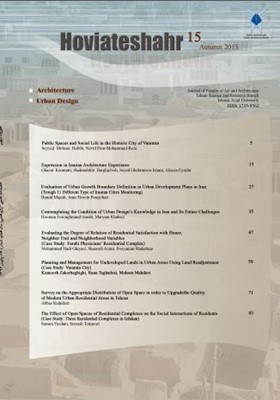Contemplating the Condition of Urban Design’s Knowledge in Iran and Its Future Challenges
Subject Areas : architectureHooman Foroughmand Araabi 1 * , Maryam Khabazi 2
1 - Master of Urban Design, Science and Research Branch, Islamic Azad University, Tehran, Iran
2 - Master of Urban Design, Science and Research Branch, Islamic Azad University, Tehran, Iran
Keywords: Urban design, Vernacular Designing, Theoretical Domains, Practical Domains, Further Necessities,
Abstract :
To make the knowledge of urban design suitable for the situation of Iran and in order to achieve vernacular urban design, besides broadening the knowledge of urban design, it is utterly crucial to evaluate today’s urban design knowledge and its circumstances. Given the fact that, after about 4 decades from the entrance of the knowledge of urban design into Iran, which seems to be an appropriate time for adjustments, the overall endeavors in both theoretical and practical fields are not successful enough. Moreover, there are not convenient investigations to determine the current condition of this field in Iran. In this paper we have tried to survey the condition of urban design’s knowledge in the main texts in Iran in both translated and compiled texts to discover the current and future challenges of this knowledge. In fact, we have surveyed all published books until winter of 1388. We have used two definitely substantial references to explain the aim of article, firstly, the article of Anne Vernez Moudon “A Catholic Approach to Organizing What Urban Designers Should Know”, we use the categories about the main domains of urban design which she introduces in her article and secondly, the book of Alexander R. Cuthbert “The Form of City”, that he introduces 40 significant texts of urban design. Texts in Iran were compared with these 40 books in different ways. The hypothesis of this research is that the knowledge of urban design has some deficiencies in both content and structure so to evaluate this hypothesis, at first we should introduce published texts and domains of urban design in Iran and then analyze the contents of them. It determines the amount of attention to these domains and the entrance trend of them into Iran and the proportion of translated books to compiled ones to find out the current criteria of urban design texts. We have used tables and some statistical ways to assess this issue. Thus, in the first table, we conclude that 65% of the most significant books of urban design which Cuthbert listed are not translated in Iran yet. Furthermore, most of books in Iran are translated, in other words, the proportion of translated books to compiled ones is 39 to 25. As far as compiled books are concerned in the second table it should be noted that most of these books take into account vernacular urban design by 75%. Finally, in the third table, we conclude that place studies have the maximum numbers of published books among other theoretical domains and picturesque studies have placed second in this ranking. Consequently, after evaluation of these tables and other deductions, we express the further challenges of urban design’s knowledge such as globalization and the question of how to deal with the gap between what we might call the ‘tradition of fixity’ and the ‘prognosis of transience’ and other challenges. In fact, we deduce that this knowledge could not reach to a purpose-built productive flux. Eventually, we propose workable solutions to improve this untenable situation.
فهرست مراجع
بحرینی، سیدحسین .(1385). طراحی شهری در ایران: نگرشی نو، هنرهای زیبا،( 26)، 13-26.
Cuthbert, A. R. (2006). The form of cities, political economy and Urban design. Oxford: Blackwell.
_||_

